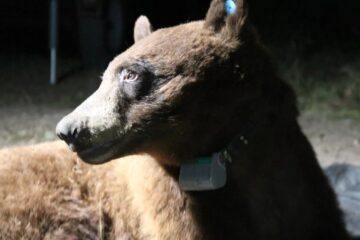Historic Joshua Tree sites blighted by city’s ills
Vandals are using social media to get others to join in. Rattlesnake Canyon and Barker Dam are temporarily closed.
Source of this article: The Los Angeles Times, April 13, 2013
JOSHUA TREE — Along the saw-toothed ridge of Rattlesnake Canyon, crude graffiti invades the crevices that offered shade to nomadic Indians trekking across the Mojave hundreds, if not thousands, of years ago.
“Skunk,” “oatmeal cookie” and “punx” are scribbled in black spray paint on giant, earth-crushing boulders where ancient petroglyphs may have been etched by the Serrano and Chemehuevi.
The damage goes far beyond a few lovey-dovey teenagers carving their initials into picnic tables. Vandalism in Rattlesnake Canyon and at Barker Dam, two of Joshua Tree National Park’s most popular hiking spots, has been so pervasive that both sites have been closed to the public.For visitors who relish the unique isolation of this harsh desert terrain, hiking amid century-old Joshua trees and jagged granite outcroppings thrust through the Earth’s crust millions of years ago, the graffiti offers an unwelcome reminder of a city life they sought to escape.
“We come to this place because it’s not as touristy as surrounding national parks, and you don’t run into as many people. You kind of feel like you’re alone. In ancient times. There’s nothing like this place,” said Butch Wood, 51, a guitar builder visiting from North Aurora, Ill. “You don’t like to see the modern world intruding on history. It’s a shame.”
The graffiti in Rattlesnake Canyon, which meanders for a mile through the northern edge of Joshua Tree’s Wonderland of Rocks, started with just a few markings but quickly became rampant. Vandals bragged of their handiwork on social media sites such as Facebook, attracting their like-minded friends to the same spot, paint in hand, park service officials said.
In all, 17 areas of the canyon have been defaced by graffiti, including several historic Native American cultural spots.
To the south, a mishmash of names, dates of conquest and scrawled professions of love have been carved into one side of Barker Dam. Cowboys cobbled the dam together with rocks and concrete a century ago, hauling in sacks of cement from Beaumont 60 miles away, to pool water for their herds during long cattle drives from Texas and Arizona to the coast.
“I’ve worked at six national parks in my career, and this is the most extensive that I’ve ever seen,” said Park Ranger Pat Pilcher, who led reporters on a tour of some of the damage. “We hope it’s isolated. We’re hoping that the public will help us out by reporting any damage or vandalism that they see.”
Park service law enforcement agents are investigating the vandalism at both sites, Pilcher said, adding that anyone convicted of defacing a national park could be sentenced to six months in jail and fined up to $5,000. The penalty could be much stiffer for those convicted of vandalizing a historic Native American site, he said.
“I don’t know what these people were thinking when they did this. It’s just meaningless, if you ask me,” said a dismayed Pilcher. “Who knows, in a hundred years they may call this rock art.”
The park service declined to provide details of the investigation, but the fact that some of the vandals appeared to have posted their handiwork online could make it easier to track them down. The park service has already found a picture online of a vandal spray-painting in Rattlesnake Canyon. Still others appeared to have scribbled their own names on the boulders, along with the date they were there.
“It’s all about the fame. They want worldwide attention,” said graffiti expert Dwight Waldo, a retired San Bernardino police investigator who consults with law enforcement agencies across the nation. “A lot of these things are posted on Facebook and stuff. These guys have their own pages.”
Once posted, the message goes out to fellow taggers that the spot is a safe place to go to, Waldo said. That attracts even more graffiti.
The rash of graffiti at Joshua Tree National Park defies the trend at parks nationwide, where vandalism has been on the decline over the past decade, said park service spokesman Jeffrey Olsen.
Still, there were 1,891 cases of vandalism reported at the 397 national parks in 2012, which included graffiti, carvings and other destruction. The agency spent $307,000 repairing the damage, Olsen said.
For local Native American tribes, the defacing of historic sites at Joshua Tree just adds to the cultural losses they have suffered since Spanish missionaries first arrived in the 1700s.
The spring-fed Oasis of Mara, near the park’s north entrance, was a popular resting spot for several tribal clans as they journeyed across the desert toward the coast, and Native American rock drawings are scattered across the vast 800,000-acre park.
“That whole area was Serrano territory,” said Jacob Coin, spokesman for the San Manuel Band of Serrano Mission Indians in Highland. “It’s a disappointment not just for Native people, but for all of the state. This is part of the rich history of California.”
It’s unclear how the park service will repair the damage at Barker Dam, since the carvings cannot simply be washed away. The dam itself is fenced off, but the popular trail around the site remains open.
To help aid cleanup efforts at Rattlesnake Canyon, which is expected to reopen in a matter of weeks, about 90 students from the Urban School of San Francisco will travel to Joshua Tree next week to scrub the graffiti off the boulders. The private high school has sent its entire junior class to Joshua Tree every year since 1994 to help fix up the park.
The students will spend five days hauling rags, water and biodegradable cleanser up the mile-long canyon.
“They’re going to find out how heavy water is,” said school spokeswoman Kris Bailey. “Science in action.”




0 Comments